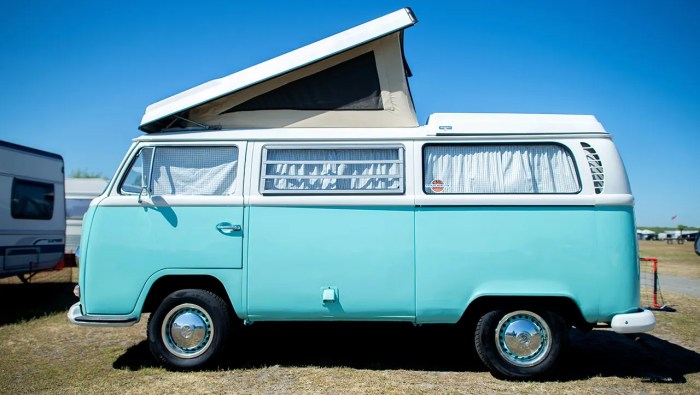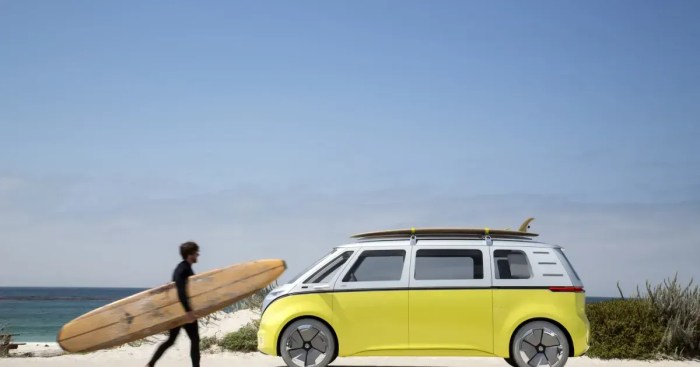The Legacy of the Volkswagen Camper
The Volkswagen Camper, affectionately known as the “Hippie Van” or “Kombi,” is more than just a vehicle; it’s a symbol of freedom, adventure, and a generation’s counterculture movement. Its history is intertwined with the evolution of society, reflecting changing values and aspirations.
Cultural Impact and Counterculture
The Volkswagen Camper’s cultural impact is undeniable. It became synonymous with the counterculture movement of the 1960s and 70s, embodying the spirit of freedom, individuality, and a rejection of traditional norms. The Camper’s spacious interior and adaptable design allowed for communal living, fostering a sense of community among its occupants. It was a mobile home, a party space, and a symbol of rebellion against the status quo.
Evolution of the Volkswagen Camper
The Volkswagen Camper has undergone several transformations throughout its lifespan, with each generation reflecting the changing times.
- The original Type 2 (T1), introduced in 1950, was a simple, utilitarian vehicle designed for practicality and affordability. Its iconic split-screen design and rounded body shape became instantly recognizable.
- The T2 (Bay Window), launched in 1967, featured a larger window design, a more powerful engine, and a more modern interior. This generation embraced the spirit of the times, becoming a symbol of the burgeoning hippie movement.
- The T3 (Vanagon), introduced in 1979, featured a more angular design, a water-cooled engine, and a more luxurious interior. This generation focused on comfort and practicality, reflecting a shift towards family-oriented vehicles.
- The T4 (Transporter), introduced in 1990, marked a departure from the classic Camper design. It featured a more car-like chassis, a wider range of engines, and a focus on safety and performance.
- The T5 (Transporter), launched in 2003, continued the evolution with a focus on modern technology, fuel efficiency, and safety. It offered a wider range of customization options, catering to a diverse range of users.
- The T6 (Transporter), introduced in 2015, represents the latest iteration of the Volkswagen Camper. It incorporates advanced features like driver assistance systems, connectivity, and a focus on sustainability.
Enduring Popularity
The Volkswagen Camper’s enduring popularity can be attributed to several factors:
- Nostalgia and Sentimentality: The Camper evokes a sense of nostalgia for a simpler time, reminding people of carefree days and adventures on the open road.
- Versatility and Adaptability: The Camper’s spacious interior and modular design allow it to be customized for a variety of uses, from camping and road trips to transporting goods and even serving as a mobile office.
- Community and Culture: The Camper has fostered a strong sense of community among its owners, who share a passion for the vehicle and its lifestyle.
- Environmental Consciousness: With the increasing popularity of electric vehicles, the Volkswagen Camper’s potential as a sustainable mode of transportation has gained renewed interest.
The Electric Revival: Iconic Volkswagen Camper May Return As An Electric Vehicle
Volkswagen’s decision to revive the iconic Camper as an electric vehicle is a testament to the brand’s commitment to sustainability and innovation. This move is driven by the growing demand for environmentally friendly vehicles and the increasing popularity of electric cars. The electric Camper represents a modern interpretation of a classic, blending nostalgia with cutting-edge technology.
Benefits and Challenges of Electrifying the Camper
The electrification of the Camper presents both benefits and challenges. The electric Camper promises a quieter and smoother driving experience, while reducing emissions and reliance on fossil fuels. However, range anxiety, charging infrastructure, and performance are crucial factors to consider.
Range and Charging Infrastructure
Electric vehicles are known for their limited range compared to gasoline-powered vehicles. The electric Camper’s range will depend on battery size and driving conditions. However, Volkswagen has stated that the electric Camper will have a range of over 200 miles on a single charge. This range is sufficient for most daily commutes and weekend trips. However, the availability of charging infrastructure remains a challenge, especially for long-distance travel. Volkswagen is working to expand the charging network and provide convenient charging options for Camper owners.
Performance
Electric motors provide instant torque, leading to impressive acceleration. The electric Camper is expected to be more responsive and powerful than its gasoline-powered predecessors. However, the weight of the battery pack might affect the vehicle’s overall handling and agility.
Comparing the Electric Camper with its Gasoline-Powered Predecessors
The electric Camper will feature a modern design that pays homage to its iconic predecessors while incorporating new technologies.
Features and Specifications
The electric Camper will offer a range of features, including a spacious interior, a comfortable driving experience, and advanced technology features. The electric Camper will likely feature a touchscreen infotainment system, advanced driver-assistance systems, and a suite of connectivity features.
| Feature | Electric Camper | Gasoline-Powered Camper |
|---|---|---|
| Engine | Electric motor | Gasoline engine |
| Transmission | Single-speed transmission | Manual or automatic transmission |
| Fuel Efficiency | High fuel efficiency | Lower fuel efficiency |
| Emissions | Zero tailpipe emissions | Produces greenhouse gases |
Design and Aesthetics
The electric Volkswagen Camper is a delicate dance between preserving the iconic charm of the original and embracing the sleek modernity of electric vehicles. It’s a design philosophy that aims to evoke nostalgia while simultaneously pushing the boundaries of automotive innovation.
The design of the electric Camper is a testament to the meticulous attention to detail that Volkswagen is known for. It’s a fusion of retro charm and cutting-edge technology, creating a vehicle that is both familiar and exciting.
Exterior Styling
The electric Camper will likely retain the signature rounded silhouette and iconic split-screen windows of its predecessors, ensuring a sense of continuity. However, expect subtle modernizations like sleek LED headlights, a more aerodynamic front grille, and a streamlined rear end. These elements will enhance the vehicle’s efficiency and appeal to a contemporary audience.
Interior Layout
Inside, the electric Camper will offer a spacious and comfortable cabin, true to its heritage. The interior will feature a blend of retro-inspired elements and modern amenities. Think plush leather seats, vintage-style wood accents, and a state-of-the-art infotainment system. The layout will be designed for optimal passenger comfort and practicality, with ample storage space and a focus on maximizing the sense of openness.
Technological Innovations
The electric Camper will be packed with advanced technology, seamlessly integrated into its design. Features like a panoramic sunroof, a digital instrument cluster, and a suite of driver-assistance systems will enhance the driving experience and provide a modern edge. The electric powertrain will offer quiet operation and impressive range, allowing for extended adventures.
“The electric Camper is not just about nostalgia, it’s about reimagining a classic for a new generation.” – Volkswagen Design Director
Market Impact and Sustainability
The electric Volkswagen Camper, a reimagining of the iconic vehicle for the modern era, is poised to make a significant impact on the automotive market and contribute to a more sustainable future. Its potential market reception, environmental benefits, and influence on Volkswagen’s brand image are crucial aspects to consider.
Market Reception and Competition, Iconic volkswagen camper may return as an electric vehicle
The electric Camper targets a diverse audience, encompassing enthusiasts of the original model, eco-conscious consumers, and families seeking a spacious and practical electric vehicle. Its retro-futuristic design and electric powertrain cater to a wide range of preferences. However, it faces competition from established electric van manufacturers like Tesla and Rivian, as well as established players in the campervan market like Mercedes-Benz and Ford.
- Target Audience: The electric Camper’s target audience includes nostalgic fans of the original model, seeking a modern interpretation of a beloved classic. Additionally, it appeals to environmentally conscious individuals who prioritize sustainable transportation and appreciate the vehicle’s zero-emission capabilities. Families and adventurers looking for a spacious and versatile electric vehicle with ample storage and sleeping accommodations are also key target demographics.
- Competitive Landscape: The electric Camper will compete against established players in the electric van market, such as Tesla’s Cybertruck and Rivian’s EDV, which offer similar features and technology. It will also face competition from established campervan manufacturers like Mercedes-Benz and Ford, who are increasingly focusing on electrification and sustainable options. However, the electric Camper’s iconic heritage and unique design could provide a distinct advantage in the market.
Environmental Impact and Sustainability
The electric Camper’s transition to an electric powertrain offers significant environmental benefits, contributing to a cleaner and more sustainable future.
- Reduced Carbon Emissions: By eliminating tailpipe emissions, the electric Camper contributes to reducing air pollution and mitigating climate change. Electric vehicles, powered by renewable energy sources, play a crucial role in achieving carbon neutrality and transitioning to a more sustainable transportation system.
- Sustainable Transportation: The electric Camper promotes sustainable transportation by reducing reliance on fossil fuels and encouraging a shift towards cleaner energy sources. This aligns with global efforts to combat climate change and promote a more environmentally responsible approach to mobility.
Impact on Volkswagen Brand Image
The electric Camper’s introduction reinforces Volkswagen’s commitment to electric mobility and sustainable transportation.
- Electric Mobility Leadership: The electric Camper demonstrates Volkswagen’s commitment to leading the transition to electric mobility and expanding its portfolio of electric vehicles. It reinforces the brand’s focus on innovation and sustainability, attracting environmentally conscious consumers.
- Brand Revitalization: The electric Camper’s iconic status and modern appeal can revitalize the Volkswagen brand, attracting a new generation of customers and appealing to a broader audience. It showcases the brand’s ability to adapt to evolving consumer preferences and market trends.
Iconic volkswagen camper may return as an electric vehicle – The return of the iconic Volkswagen Camper as an electric vehicle is a bold move that could have a profound impact on the automotive industry and the way we think about travel. The electric Camper has the potential to attract a new generation of enthusiasts while also contributing to a more sustainable future. It remains to be seen how the electric Camper will be received by the market, but one thing is certain: the legacy of the Camper, a symbol of freedom and adventure, is set to continue in a new, electrified form.
The iconic Volkswagen Camper, a symbol of freedom and adventure, is rumored to be making a comeback, this time as an electric vehicle. It seems like everyone’s jumping on the electric bandwagon, but will supply chain issues hold them back? We’ve already seen hints of this with Apple Watch shipping estimates , suggesting a potential shortage. If VW can overcome these challenges, the electric Camper could be the perfect blend of nostalgia and sustainable driving.
 Standi Techno News
Standi Techno News

